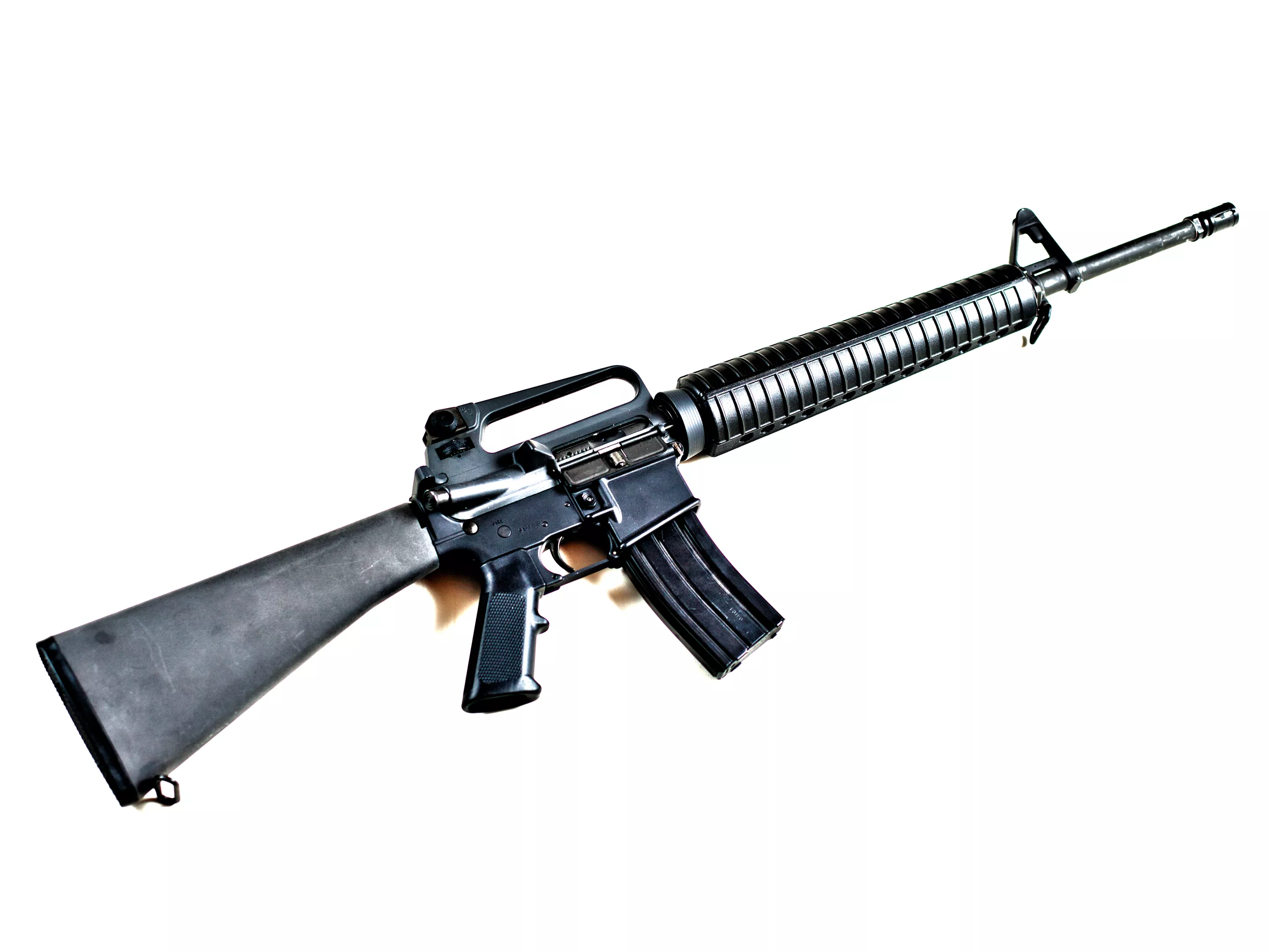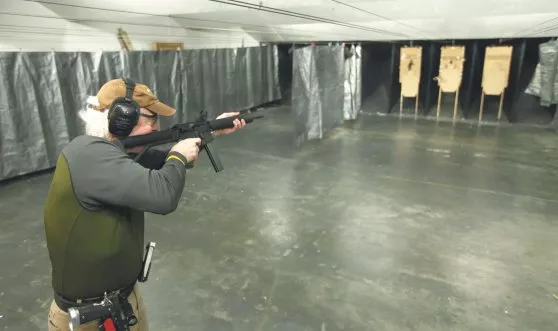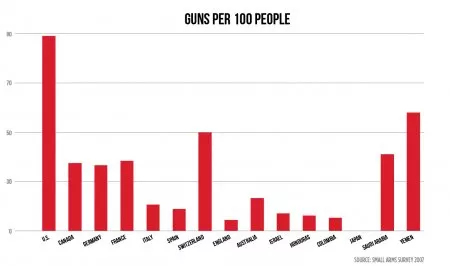Black gunmetal strikes coarse against the skin. With its stout and angular design, the AR-15 semiautomatic rifle hangs light in the hands. Shadows catch along the sharp edges of the gun’s frame.
Cold and unvarnished, the rifle reflects a ruthless efficiency. Cradle the weapon against one arm. With another hand, click the curved magazine into the underside of the gun.
To load a bullet, draw back the lever. Let it slam forward with a heavy click-clack. Sight down the long, dark barrel. Breathe in. Breathe out.
Squeeze the trigger.
A .223-caliber bullet explodes from the muzzle at more than 3,200 feet per second. The rifle jerks, recoiling lightly into the shoulder.
Whether punching a small hole in a paper target or committing mass murder, the rifle works the same. As the weapon of choice for society’s guardians, sports shooters and madmen, the AR-15 rifle occupies a fearsome place in American culture.
Overwhelmingly outselling all other rifles, the AR-15 and its many modern facsimiles have flooded gun markets and reshaped the national firearms industry. Experts now estimate more than 3.5 million AR-15-style rifles exist in circulation.
But every characteristic driving the rifle’s popularity among soldiers and sportsmen — high accuracy, reliability and versatility — also made it a terrifying killing machine in the hands of recent mass murderers in Newtown, Conn., Clackamas, Ore., and Aurora, Colo.
“People look at that gun right away and they make assumptions about who owns it and what it’s going to be used for,” says Lee Wilson, president of the local Sharp Practical Shooters club.
Developed amid the deadly chaos of Vietnam and once outlawed under a federal assault weapons ban, the AR-15 teeters at the center of the emotionally charged gun debate, at the intersection of civil rights and civil society. Who can we trust with semiautomatic rifles? Do we want to disarm our neighbors, or do we want to arm ourselves against them?
America has long struggled, Wilson says, with a divided culture that glorifies violence in media while refusing to confront the complicated nuances of gun violence. More than any other firearm, the “black rifle,” as it’s often called, could also be called the American Rifle.
“We have got a love affair with guns,” Wilson says. “And we have got a hate affair with guns.”
In the weeks since the Newtown shooting, familiar battle lines have emerged on television and Capitol Hill. Fox News fuels fear of overreaching gun control while Jon Stewart brandishes a plastic machine gun on The Daily Show. Heavily armed survivalists decry a new wave of tyranny. Peaceniks tout sensationalized body counts. Extreme voices drown out moderate discussion.
51% of Americans oppose a new assault weapons ban. - Gallup, Dec. 19-22, 2012
Wilson, a retired school administrator and labor consultant, believes gun enthusiasts and gun control advocates should seek common ground. They should embrace dialogue.
Under the fluorescent glow of his workshop lights, Wilson shows off an AR-15-style rifle. He rotates the rifle in his hands and pulls two pins from the body of the weapon. It slides apart in two pieces, and Wilson holds up both halves to reveal an interior of steel springs, levers and latches.
“Although it’s a tool capable of killing people, it’s still just a machine,” he says. “It’s no more intimidating than you allow it to be.”
More than 50 U.S. companies now manufacture complete rifles or accessories for AR-15-style weapons. Commonly called “assault rifles” by gun control advocates and more recently rebranded as “modern sporting rifles” by shooting groups, the gun has several defining features.
“To its champions, the AR-15 was an embodiment of fresh thinking. Critics saw an ugly little toy.”
All legal AR-15 rifles must be semiautomatic, firing once for each trigger pull. A detachable magazine clips in under the weapon to feed bullets into the gun. Magazines come in a wide range of capacities from five bullets to 100-round drums.
Part of the popularity of the rifle stems from its versatility. Barrel sizes and calibers can be changed easily. Many rifles also include rail mounts for attaching scopes, lights, lasers, slings or other accessories.
In 1954, small arms engineer Eugene Stoner dreamed of redefining the U.S. military rifle. Once a Marine in World War II, Stoner later served as chief engineer for ArmaLite, a fledgling firearm division under the Fairchild Engine and Airplane Corporation. His patents would lay the foundation for the next generation of weaponry.
“ArmaLite believed that a ready market existed for firearms of advanced design featuring lightweight, modern alloys and plastics, and economical production procedures,” the company history states.
Stoner, along with two other designers, first engineered the AR-5, a small survival rifle, out of aircraft aluminum. The company later adapted the design into a larger, .308-caliber infantry rifle called the AR-10.
The U.S. Army did not adopt the AR-10, but asked ArmaLite to develop a third rifle that would fire a smaller round with greater speed and reliability, the company states. After specifically developing the .223-caliber bullet to meet the military’s ballistic requirements, ArmaLite introduced the AR-15 rifle.
In his book The Gun, journalist C.J. Chivers says that the AR-15 benefitted from well-timed hype and an American military desperate to find a lightweight machine gun capable of taking on the AK-47 in the jungles of Vietnam.
“Its appearance — small, dark, lean, and synthetically futuristic — stirred emotions. A rifle, after all, was supposed to look like a rifle,” Chivers writes. “To its champions, the AR-15 was an embodiment of fresh thinking. Critics saw an ugly little toy.”
While the AR-15 received some positive feedback, ArmaLite’s financial limitations forced them to sell the design to the Colt’s Manufacturing firearm company in 1959. Colt later won the military contracts and the rifle’s fully automatic counterpart, the M-16, was issued into combat.
After five decades of civilian and military success, Colt still controls the official “AR-15” trademark, so named AR for ArmaLite. In the years since, the rifle’s legacy has continued to grow, inspiring scores of imitation rifles based on Stoner’s initial platform.
Along a mossy stretch of the Old Pacific Highway, east of Olympia, Wash., the Olympic Arms Inc. firearms factory occupies a small break in the evergreens. Painted slate blue with an American flag hoisted out front, the family-owned AR-15-style rifle company operates out of a former grange building.
Owner Brian Schuetz (pronounced “shoots”) offers a hearty handshake before heading into the main manufacturing building. The drone of heavy equipment and the grind of steel fills the factory.
“We’re still one of the very few companies that makes everything in house,” he says.
His father, 84-year-old Robert Schuetz, started as a gun barrel maker in Colorado under the name Schuetzen Gun Works. When military contracts brought him to Fort Lewis, the company transitioned to Olympic Arms in the early 1980s. The family started selling surplus M-16 parts and newly fabricated AR-15 parts. They now employ 50 workers and produce 800 to 1,300 complete AR-15-style rifles a month.
“I basically started working here when I was 14,” Brian Schuetz says. “This was where I wanted to be. … I didn’t go to a machining school to learn this. I didn’t go to a gunsmith school. I pretty much learned through my father and through my own experimentation here.”
Schuetz, 51, overalls buttoned over his large shoulders, squeezes between rows of humming machines. He has programed the dimensions of each stainless steel piece into the shaping machines. When he first started designing guns, only a couple companies offered AR-15s; now every major firearms manufacturer makes a version of the weapon.
Olympic Arms Sales Director Tom Spithaler says the increased popularity of the AR-15 has helped legitimized the rifle, but also opened it up to criticism. The entire industry came under siege in 1994 when Congress passed the federal semiautomatic assault weapons ban.
Both supporters and opponents of the federal ban — which prohibited the manufacturing of certain assault-style rifles and high-capacity magazines from 1994 to 2004 — acknowledge the ban barely dented the production of AR-15s. Spithaler says Olympic Arms made minor adjustments to their design and put out the PCR model, the “Politically Correct Rifle.”
“Nothing as far as how the rifle worked or operated changed,” he says. “It was just cosmetics. We were able to make those changes and we had new ones out within days.”
A research coordinator with the National Rifle Association estimated in 2007 at least 3.5 million AR-15-style rifles had been manufactured since Colt introduced the first civilian, semiautomatic version in 1963. Those estimates only count the totals of companies, like Olympic Arms, that focus almost exclusively on the particular rifle.
Production of the rifles has exploded in the past few years as traditional firearm companies adopted the rifle platform and small companies clamored to produce niche AR-15 accessories. New models from larger companies like Smith & Wesson or Remington could push the current total number of all assault-style rifles to as high as 10 million.
Despite the surging popularity of the rifle, Schuetz says the recent shootings and proposed gun restrictions threaten to criminalize his way of life.
“Forty years ago, it was pretty neat to say you were a gunsmith,” he says. “Now it’s such a political hot button.”
In the weeks since the Dec. 14 massacre of 20 young children and six educators at the Sandy Hook Elementary School in Newtown, Conn., much of the national conversation has focused on gun violence. Proposed solutions have ranged from arming teachers to reinstating the previous federal ban on AR-15s and other semiautomatic assault weapons.
Connecticut shooter Adam Lanza reportedly used an AR-15-style Bushmaster .223-caliber rifle in the Newtown shooting. Mass shooters also used similar rifles in the Dec. 10 killing of two people at the Clackamas Town Center south of Portland, Ore., along with the killing of 12 people at an Aurora, Colo., movie theater on July 20.
California Sen. Dianne Feinstein, who sponsored the 1994 assault weapons ban, has written a new, further-reaching ban she hopes to pass at the federal level. The preliminary bill would outlaw more than 100 AR-15 and other assault-type rifles by name along with any firearms with certain military features. Her proposed bill, along with several other ones under consideration, would also ban “high-capacity” ammunition magazines that hold more than 10 bullets.
“As I have said many times before — and now repeat in the wake of yet another tragedy — weapons of war don’t belong on our streets or in our theaters, shopping malls and, most of all, our schools,” Feinstein says in a statement. “I hope and trust that in the next session of Congress there will be sustained and thoughtful debate about America’s gun culture and our responsibility to prevent more loss of life.”
Newly sworn Washington Gov. Jay Inslee would likely support state-level efforts to impose new gun restrictions. Spokesman Sterling Clifford says the Governor’s Office may not introduce any new legislation, but Inslee hopes to pursue reasonable gun regulation.
“[Inslee] has expressed support for renewing the assault weapons ban,” Clifford says. “He voted for the ’94 bill, and there’s nothing in it that he’s said he would not support again.”
Clifford says the governor also remains open to discussing bans on high-capacity magazines or empowering individual cities to tighten their own gun regulations as citizens see fit. He argues Seattle has different firearm concerns than Yakima or Pullman.
“We do need to have a serious conversation about all the contributing factors,” Clifford says.
The Seattle Times recently reported bipartisan support for increasing penalties on juveniles illegally possessing guns and expanding the state’s options for committing people diagnosed as dangerous. State Sen. Mike Padden, R-Spokane Valley, is expected to chair a committee on the issue.
However, gun rights supporters have argued for legislative restraint throughout the highly emotional aftermath of the Newtown shooting. U.S. Rep. Cathy McMorris Rodgers, R-Wash., told C-SPAN the day of the Newtown shooting that lawmakers should not rush to quick conclusions.
“I think we have to be careful about … suggesting new gun laws,” she says in the interview. “We need to look at what drives a crazy person to do these kind of actions and make sure that we’re enforcing the laws that are currently on the books.”
Idaho Sen. Mike Crapo, a Republican with an A+ rating from the NRA, also opposed any new gun regulation, arguing on Boise Public Radio that efforts to prevent mass killings should focus on mental health issues.
“I continue to disagree that increased gun control is going to resolve the issues of violence that we have in our society,” Crapo says. “The weapons that are probably going to be included in this new proposal are simply the kind of firearms that people who live in states like Idaho and other places ... [use] for hunting and for self-defense.”
The National Rifle Association, the country’s largest gun rights organization and political lobby, has led a full-throated defense of AR-15s and other semiautomatic weapons. In a highly publicized news conference a week after the Newtown shooting, vice president Wayne LaPierre accused the media of reporting misinformation and deliberating “demonizing” the rifle.
“The media call semiautomatic firearms ‘machine guns’ — they claim these civilian semiautomatic firearms are used by the military, and they tell us that the .223 round is one of the most powerful rifle calibers when all of these claims are factually untrue. They don’t know what they’re talking about.”
LaPierre blamed media violence and “gun-free zones” for emboldening killers and argued for armed security guards in all schools. He stuck to a simple message: “The only thing that stops a bad guy with a gun is a good guy with a gun.”
The NRA reports more than 100,000 new members have joined the organization since the Newtown shooting.
The FBI has also seen a significant increase in the number of background checks being filed for new firearm purchases. In Washington, demand rose from 50,452 checks in November to 74,447 checks in December. In Idaho, those checks jumped from 13,395 to 20,555. Applications for concealed weapons permits have also skyrocketed nationwide.
The Brady Campaign to Prevent Gun Violence has responded with increased calls for the prohibition of AR-15 and other semiautomatic rifles. Gun control advocates believe the Newtown shooting may be a “tipping point” in the debate on gun regulation.
“The Brady Campaign supports banning military-style semiautomatic assault weapons along with high-capacity ammunition magazines,” the Brady Campaign website states. “These dangerous weapons have no sporting or civilian use. Their combat features are appropriate to military, not civilian contexts.”
More than 197,000 people signed an online “We the People” petition to the White House demanding “immediate” action on gun control. The number of supporters surpassed any previous petition totals for the website.
Ralph Fascitelli, board president of Seattle-based Washington Ceasefire, says many firearms have practical applications that justify their civilian possession, but he argues assault-type rifles and high-capacity magazines only facilitate killing. The organization would like to see a renewed ban on the weapons.
“Why would anyone need something that shoots 100 bullets a minute for hunting?” he asks. “We think that assault weapons, like the AR-15, have no place in our society.”
Washington Ceasefire organized a large march in Seattle this past Sunday to show public support for increased gun regulation. Fascitelli says lawmakers should find a “balance,” but he believes semiautomatic rifles go beyond reasonable civilian weaponry.
“I don’t understand the satisfaction of having that much firepower,” he says. “Why was this ever allowed?”
Dulled sounds of gunfire thump through the wall to his office just as the phone rings with another worried caller. As owner of the Center Target Sports gun shop and indoor shooting range in Post Falls, Ed Santos has served as a local clearinghouse for questions and concerns over potential gun regulations.
“I have fielded at least 10 calls today,” he says. “I would say it’s more tense this time. … We’ve never experienced this before.”
Santos, a retired Army officer and reserve deputy, opened Center Target Sports eight years ago, around the same time the federal assault weapons ban expired. While the AR-15 has previously attracted some public criticism, he says he’s never seen such an aggressive effort to outlaw the weapon.
“There’s nothing wrong with this firearm,” he argues. “This firearm does not have a mind of its own. … The popularity is not because people went on a feeding frenzy and wanted to get this military weapon. Absolutely not. They see the value in the design.”
Santos says the recent proposals to ban the weapon have done nothing but drive up sales and prices to unprecedented levels. More than 155,000 rifles were sold in a single day the week after the Newtown shooting, he says. People who had debated buying the rifle told him they decided they finally had to after lawmakers threatened to ban them.
“[Gun control advocates] single-handedly put more ARs into the hands of people in one day than we had all the year of 2012,” he says.
Countless gun stores across the country have reported selling out of AR-15s. Many reported wholesalers and distributors completely tapped out of inventory. Likewise, high-capacity magazines, capable of holding more than 10 rounds, have seen increased demand.
Santos pointed to a bare strip of wall where AR-15s used to hang. Robin Ball, owner of Sharp Shooting Indoor Range in Spokane, confirmed the same problem. Dozens of customers who came in the week after the shooting left empty-handed.
“We sold out of our back stock,” Ball says.
Gun shows have also experienced a surge in AR-15 transactions. Several times a year, Lewis Clark Trader hosts a 400-table gun show at the Spokane Fair and Expo Center. Less than a week before the Newtown shooting, on Dec. 8, AR-15s could be purchased for about $900.
Gun shoppers casually paced the rows of rifles, handgun and firearm accessories during that show, hoping to spot a deal. Oversized machetes labeled “Zombie Killer” and brass knuckles were more talked about than any assault weapons ban.
Just a few weeks later — after the Newtown shooting — hundreds of people packed into the fairgrounds on Jan. 5 as eager buyers and sellers looked to check out the local AR-15 market. The line stretched back 60 feet. People waiting to sell rifles stood impatiently with the guns slung over their shoulders.
Gun show promoter Paul Snider says they had expected increased attendance. Most vendor tables had sold out weeks in advance. He notes about 40 percent of the vendors are licensed dealers who still must call in a background check for every gun sale.
“They’re concerned about what’s going to happen down the line,” he says of gun buyers. “There’s an impact in that, no question.”
AR-15-style rifles that sold for $900 just weeks before had doubled in price, now selling for $1,800. Some higher-end models sold for upwards of $2,500. One man selling ammunition rushes to keep up with questions from customers on all sides. Several racks of AR-15 .223-caliber bullets sit empty.
“It’s been crazy,” he says.
The National Shooting Sports Foundation, a large firearms industry trade association coincidentally headquartered in Newtown, Conn., has long championed the competitive and hunting uses of AR-15s. In 2010, the federation produced an online survey of more than 7,300 owners of what they prefer to call “modern sporting rifles,” or MSRs, to illustrate who owns the rifles and what they want in a product.
While the questions were self-reported and skewed to more frequent firearm website visitors, the federation released an 83-page report on who owns these weapons. They concluded the average owner is older than 35 and married with some college education.
“The top reasons why consumers own a [modern sporting rifle] are; recreational target shooting, home defense, collecting and hunting,” the report states. “Overall, approximately 99 percent of all MSR owners owned some type of firearm prior to their first MSR purchase.”
The federation report also highlighted the rifle’s popularity among current and former members of the military and law enforcement. They concluded about 44 percent of AR-15-style rifle owners had some experience with law enforcement or the military.
In a separate 2012 report, the federation estimated the firearms industry contributes an annual impact of $31.8 billion in national economic activity. Nearly 210,000 jobs hinge directly or indirectly on the gun and ammunition sales.
“During difficult economic times and high unemployment rates nationally, our industry has grown and created over 26,325 new, well-paying jobs over the past two years,” the report states. “Our industry is proud to be one of the bright spots in this economy.”
The report listed 3,968 jobs in Washington state with nearly $155 million in wages and approximately $473 million in total economic impact. Idaho has 3,116 jobs with more than $131 million in wages and $512 million in total impact.
A critical 2011 study on the U.S. firearms industry from the Violence Policy Center argues gun makers have resorted to militarizing civilian firearms to drum up sales in a declining market. The report suggests gun advertising and product development has focused on “tactical” weapons in recent years to invoke fear or take advantage of military themes such as honor or patriotism.
“In short, the gun industry designs, manufactures, imports, and sells firearms in the civilian market that are [for] all intents and purposes the same as military arms,” the report states. “It then bombards its target market with the message that civilian consumers — just like real soldiers — can easily and legally own the firepower of militarized weapons.”
With baby boomers aging out of the market and younger generations growing up without a tradition of gun ownership, the center’s report argues gun manufacturers have used military imagery to drive up sales. The report includes several civilian rifle advertisements featuring police officers, soldiers or military spokespersons.
“In spite of the gauzy imagery of its advertising, the gun industry’s militarization is simply a business strategy aimed at survival: boosting sales and improving the bottom line,” the report states. “The hard commercial fact is that military-style weapons sell in an increasingly narrowly focused civilian gun market. True sporting guns do not.”
Fresh snow blankets the shooting lanes, but Spokane Police Rangemaster Sgt. Matthew Cowles can still point out where the new targets will soon hang 100 yards away. Spokane officers have long carried AR-15-style rifles, but this spring they will have a new, longer practice range for training with the weapon.
“People see this [rifle], and they think that it’s more dangerous,” Cowles says. “It’s got this military style to it. You see a police officer with it and you think it’s aggressive. There’s a perception that it’s aggressive policing, but it’s so much safer than a handgun for the general public because it’s more accurate.”
Since 1997, law enforcement agencies have served as a large market for AR-15s. That year, two men armed with automatic weapons and heavy body armor stormed a Bank of America branch in North Hollywood, staging a shootout with police that left 11 officers wounded. Departments quickly realized they were capable of being outgunned and now almost all issue some type of assault-style patrol rifle to officers.
Police officers find the rifle invaluable, Cowles says, because it’s highly accurate, lightweight, reliable and can accommodate large magazines. While he believes civilians retain the right to own such rifles, he admits the weapons can be fearsome in the wrong hands.
“If you have a person who is intent on hurting people or engaging law enforcement,” he says, “it is a scary and dangerous prospect to have an adversary who is armed with one of these.”
Spokane Police Chief Frank Straub says he thinks the country is ready for a conversation about gun access and community safety. He says he supports the right to bear arms, but he also believes it may be too easy for some people to get semiautomatic rifles.
“I’m not an advocate to take guns away,” he says. “[But] police agencies across the country are coming across high-capacity magazines and assault rifles much more than they should be.”
(Violence Policy Center report on assault weapon use against law enforcement.)
The chief says he would support some efforts to restrict purchases of AR-15-style rifles to certain collectors or dealers, but stopping gun violence also has to include personal responsibility. Gun owners must secure guns, he says, and be aware of who has access to them.
“I think it’s pretty obvious that there’s a significant threat out there,” he says.
Growing up in Wyoming and Alaska, Lee Wilson came of age with a rifle in hand. He received his first gun, a .22-caliber rifle, when he turned 11. Throughout much of his youth, he plinked aluminum cans or hunted alongside Inuit natives in the small village where his parents worked.
“Growing up in Wyoming is a lot different than growing up in Upstate New York,” he says.
As a former labor consultant for the Anchorage School District and ethics instructor, Wilson represents a minority in the shooting community. He estimates he fired 12,000 rounds in the past year, but he also voted for President Obama.
His early life experiences likely set his position on firearms, he says. Some people may inherit a tradition of hunting or self-reliance. Others may have lost a loved one to gun violence or been victimized themselves. Wilson adds that his wife dislikes guns because her brother once goaded her into shooting a bird that she didn’t want to kill.
Similar to other highly charged topics like abortion, Americans tend to hold guns close to their identities, often falling very in favor or very against, he says.
“People come to their positions on some basis other than reason,” he says. “They have strong feelings and that’s where they are.”
Will Parks, director of the Spokane-based Inland Northwest Action Shooters club, considers his right to bear arms a non-negotiable liberty. As a federally licensed gun dealer and NRA instructor, he believes all responsible citizens should be able to own AR-15-style rifles.
“It’s a symbol of freedom,” he says. “I’m a decent citizen and my government should trust me. … We’re all reasonable, good, law-abiding citizens.”
Brian Schuetz, the owner of Olympic Arms, acknowledges frustration over the bitter debate. He says he can see why some people fear guns, but he wishes more would take time to see his side. His factory represents his American dream — a successful manufacturing business, built up by father and son.
Schuetz says his own son recently graduated from Gonzaga University, but who knows if the family business will always be there for him to pass on?
“It’s always kept me wondering if I’ll have a manufacturing plant six months from now, will I have one a year from now,” he says. “As much as I hate politics, you become very political just because of what you do. It’s something I don’t enjoy. I’d rather just do what I do and not worry about it.”
Emotions run high across the board. Some people contacted for this story declined to be interviewed. Almost all expressed concern about their safety, privacy or fear of being misrepresented on such a sensitive subject.
Fascitelli, with Washington Ceasefire in Seattle, refused an in-person interview because the idea made him “nervous.” He explained a previous Washington Ceasefire president, Assistant U.S. Attorney Tom Wales, was shot and killed in his Queen Anne home in 2001.
Too many “gun happy” people in Eastern Washington, he says. He’s not risking his life for a story.
“We’re dealing with guns here,” he says before swearing and hanging up the phone.
With his AR-15-style rifle in hand, Wilson steps into his firing lane at the Sharp Shooting Indoor Range. A few friends have gathered for a weekly practice match. Rapid gunfire reverberates through the range while they load bullets into their magazines.
With a sly grin, Wilson motions to his AR-15.
“It’s the ugly black gun,” he jokes. “Evil incarnate.”
More than 310 million handguns, rifles and shotguns exist in the United States today, estimates say. Almost one weapon for every man, woman and child. Wilson says the country needs to recognize that reality. Guns are not going away anytime soon.
“Not only is the horse out of the barn,” he says, “it has populated and has progeny all over the valley.”
Semiautomatic rifles will remain center stage this week as thousands of competitive shooters, firearm dealers and industry reps gather in Las Vegas for the 2013 SHOT Show. Enthusiasts from more than 100 countries plan to showcase the latest in firearms training and technology.
While hundreds marched in favor of an assault weapons ban in Seattle this past Sunday, some thousands may observe a newly announced “Gun Appreciation Day” this Saturday.
Obama meanwhile plans to announce his first actions on gun control this week after reportedly considering 19 proposed executive orders on the issue. Potential orders could tighten background checks, track gun inventories or limit arms imports.
Wilson hopes gun owners and others will be able to come together on some practical issues. Both sides have spent years blaming problems on each other.
“If you want to have a serious dialogue with people whose views are fundamentally different from yours,” he says, “you have to avoid poking them with a stick.”
At the range, Wilson readies his rifle. He leans forward with his arms tensed, muzzle pointed down. Behind him, other shooters wait to watch him shoot. They don’t care about his politics or social positions. They care that he follows the range rules and respects others. Mostly, they just care about his aim.
If everyone focuses on what they have in common, Wilson says, maybe they can start a conversation.
“Let’s talk about other things first and build a dialogue,” he says. “Then we’ll talk about guns. … Somebody’s got to reach out.”
As the starting tone sounds, Wilson jerks forward and raises the rifle to his shoulder. He lines up his target, takes a breath, and pulls the trigger.
























